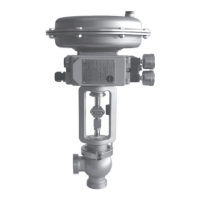EB 8097 EN 9
Assembling valve and actuator
3 Assembling valve and actua-
tor
The basic pneumatic actuator can be re-
placed by a pneumatic actuator with addi-
tional handwheel or by an electric actuator.
The standard pneumatic actuator can be re-
placed by a smaller or larger actuator for all
nominal valve sizes.
If the travel range of the actuator is larger
than the travel of the valve, the springs in the
actuator are preloaded by SAMSON so that
the travel ranges match.
3.1 Assembly and adjustment
Proceed as follows if the valve and actuator
have not been assembled by SAMSON or if
the actuator is to be replaced by an actuator
of another type or size:
1. Loosen the lock nut (6.2) and stem con-
nector nut (6.1) on the valve. Firmly
press the plug together with the plug
stem into the seat. Thread down the lock
nut and stem connector nut.
2. Remove the clamps of the stem connector
(7) and the ring nut (8.2) from the actua-
tor (8).
3. Slide the ring nut over the plug stem.
4. Place the actuator onto the valve bonnet
(5) and secure it with the ring nut (8.2).
5. Read the bench range (e.g.0.2 to 1bar)
and the actuator's fail-safe action (e.g.
"actuator stem extends") from the actua-
tor's nameplate.
The fail-safe action "actuator stem ex-
tends" or "actuator stem retracts" is
marked by FA or FE on the Type3271
Actuator, and by a corresponding sym-
bol on the nameplate of the Type3277
Actuator.
The lower value corresponds to the lower
bench range value to be adjusted,
whereas the upper value corresponds the
upper bench range value.
During assembly, make sure that the stem
seal (5.1) is not damaged.
The maximum possible actuator travel must
not exceed the maximum permissible valve
travel (see adhesive label on the yoke).
6. For actuators with "actuator stem ex-
tends" fail-safe action, apply a signal
pressure that corresponds to the lower
bench range value (e.g. 0.2 or 0.4bar)
to the connection on the bottom dia-
phragm chamber.
For actuators with "actuator stem re-
tracts" fail-safe action, apply a signal
pressure that corresponds to the upper
bench range value (e.g. 1bar) to the
connection on the top diaphragm cham-
ber.
7. Screw on the stem connector nut (6.1) by
hand until it touches the actuator stem
(8.1). Turn it a further ¼turn and secure
this position with the lock nut (6.2)
8. Position clamps of the stem connector (7)
and screw them tight.
NOTICE
!

